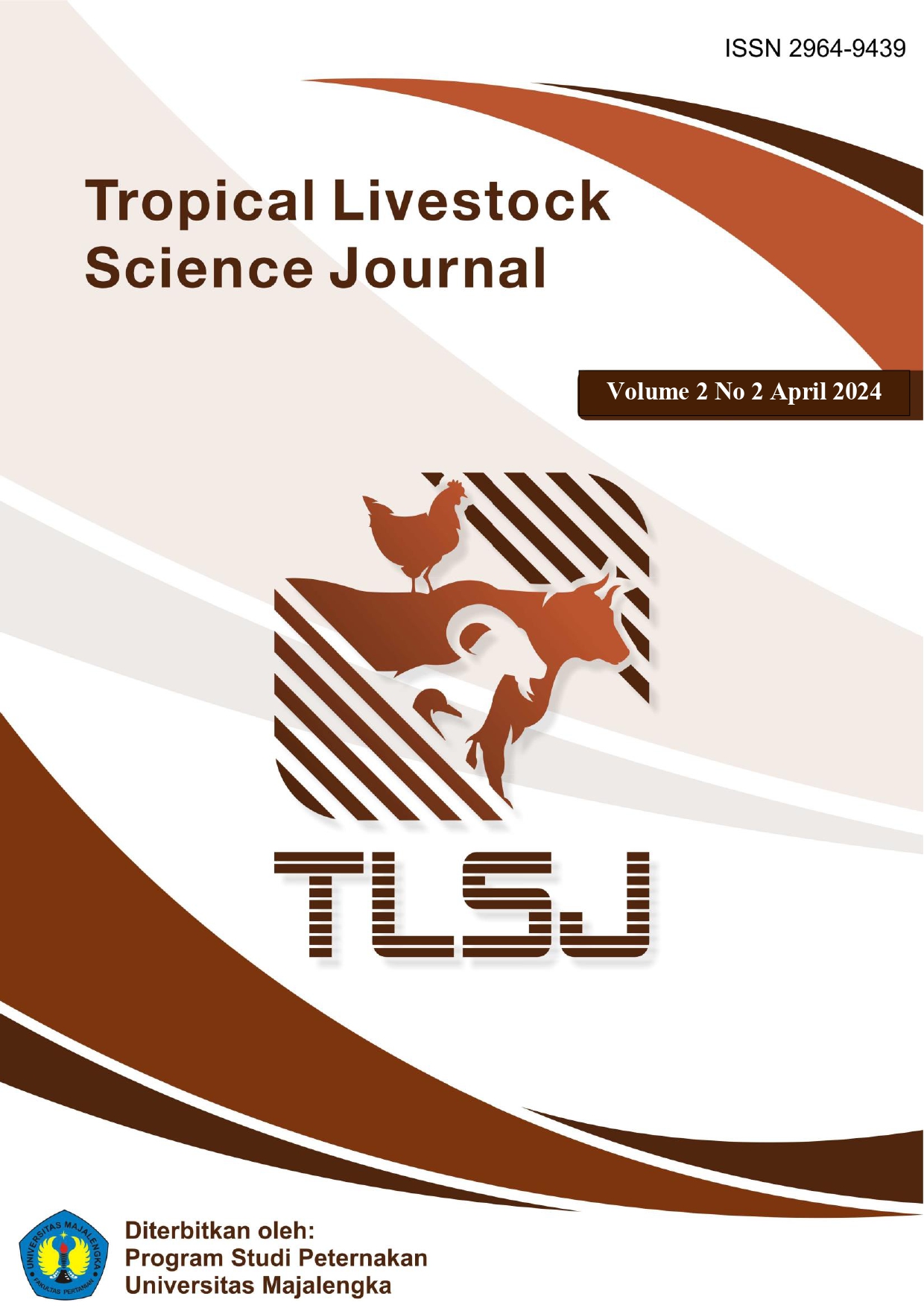Deteksi Larva Cacing Pada Sapi dengan Pola Pemeliharaan yang Berbeda di Wilayah Kabupaten Sumedang
DOI:
https://doi.org/10.31949/tlsj.v2i2.9011Abstrak
The aim of this research is to analyze differences in levels of digestive tract worm infections in cattle with different rearing patterns in the Sumedang Regency area. The research was carried out in January 2024 in the Paseh sub-district, Sumedang Regency. Worm larvae detection examinations were carried out at the Subang Veterinary Laboratory (B-VET), Jln. Garuda Canal, Werasari Block, Dangdeur, Subang District, Kab. Subang. The method in this research is descriptive observational carried out in the field and laboratory. The technique for collecting feces samples is carried out rectally, approximately 5 grams per cow, selecting samples based on simple random sampling. Fresh feces were put into 50 ml jars along with formalin to prevent eggs from hatching during transportation and storage. Each sample is given a label that includes the sample code and age information. After that, the samples are carried using a coolbox from the sampling location until they are examined in the laboratory. The research results showed that the prevalence pattern of worm infections in semi- intensive rearing was higher than in intensive rearing. The types of worms identified are Nematoda, Trematoda and Protozoa. Different maintenance patterns (Semi-intensive and Intensive) in Paseh District are classified as mild infections (1 – 156 epg).
Kata Kunci:
Worm Eggs, Rearing Patterns, Beef Cattle, Semi-Intensive, IntensiveUnduhan
Referensi
Aminah, A., Setiani, R. I., & Ekawasti, F. 2022. Identifikasi Endoparasit pada Sapi Brahman Cross (BX) di Rumah Potong Hewan (RPH) Kota Tangerang. Acta Veterinaria Indonesiana, October, 41–48.
Beriajaya. Priyanto Dwi. 2007. Efektifitas Serbuk Daun Nanas Sebagai Antelmintika Pada Sapi Yang Terinfeksi Cacing Nematoda Saluran Pencernaan. Prosiding Seminar Nasional Teknologi Peternakan dan Veteriner hlm 162-169.
Boomker J. 2015. Helminth Infections of Ruminants. Univ of Pertoria. Pp: 1–46. Budiharta Setyawan. 2002. Kapita Selekta Epidemiologi Veteriner. Yogyakarta:
Dwinata M, Suratma NA, Oka IBM, Agustina KK. 2018. Gastrointestinal Parasites of Bali Cattle Maintained at The Final Landfills in Suwung Denpasar. Bul. Vet. Udayana 10(2): 162–168.
Ekawasti F, Wardhana AH, Sawitri DA, Martindah E. 2021. Trematode and Nematode Gastrointestinal Infections in Livestock from Different Geographical Regions in Indonesia. International Seminar on Livestock Production and Veterinary Technology. Proc. Intsem LPVT 2021: 255– 267.
Gasbarre LC, Leighton EA & Davies CJ. 1990. Genetic control of immunity to gastrointestinal nematodes of cattle, J Veterin Parasitol 37: 257–272
Hamid PH, Kristianingrum YP, Prastowo J, da Silva LMR. 2016. Gastrointestinal Parasites of Cattle in Central Java. Am. J. Anim. Vet. Sci. 11(3): 119– 124.
Huang CC, Wang LC, Pan CH, Yang CH, Lai CH. 2014. Investigation of Gastrointestinal Parasites of Dairi Cattle Around Taiwan. J. Microbiol. Immunol. Infect. 47(1):70–74.
Kabaka WM, Gitau GK, Kitala PM, Maingi N, Leeuwen JAV. 2013. The Prevalence of Gastrointestinal Nematofde Infection and Their Impact on Cattle in Nakuru and Mukurweini Districts of Kenya. Ethiop. Vet. J. 17(1): 94–104
Levine Norman D. 1990. Textbook of Veterinary Parasitology. Terj. Gatot Ashadi. Ed. Wardiarto. Buku Pelajaran Parasitologi Veteriner. Yogyakarta: Gadjah Mada University Press.
Lopes LB, Nicolino R, Capanema RO, Oliveira CSF, Haddad JPA, Eckstein C. 2016. Economic Impacts of Parasitic Diseases in Cattle. CABI Wallingford UK
Mage Christian. Bourgne Henri. Toullieu Jean Marc. Roundelaud Daniel. Dreyfuss Gilles. 2002. Fasciola hepatica and Paramphistomum daubneyi: Changes in Prevalences of Natural Infections in Cattle and in Lymnaea truncatula from Central France Over the Past 12 Years. J Vet. Res no 33: 439-447.
Mubarok S, Suratma NA, Dwinata IM. 2015. Prevalensi Trematoda di Sentra Pembibitan Sapi Bali Desa Sobangan, Kecamatan mengwi, Kabupaten Badung. Indonesia Medicus Veterinus 4:48-53
Muhami M & Haifan M. 2019. Evaluasi Kinerja Rumah Potong Hewan (RPH) Bayur, Kota Tangerang. J. IPTEK. 3(2):200–208
Munadi. 2011. Tingkat Infeksi Cacing Hati Kaitannya dengan Kerugian Ekonomi Sapi Potong yang Disembelih di Rumah Potong Hewan Wilayah Eks- Karesidenan Banyumas. Agripet 11:45–50.
Raza MA. Murtaza S. Bachaya HA. Hussain A. 2009. Prevalence of Paramphistomum cervi in ruminants slaughtered in district Muzaffar Garh. Pakistan Vet J. 29 (4): 214-215.
Regassa F, Sori T, Dhuguma R, Kiros Y. 2006. Epidemiology of gastrointestinal parasites of ruminant in Western Oromia, Ethiopia. Intern. J. Appl. Res. Vet. Med. 4(1): 51-57
Tantri Novese. Setyawati Tri Rima. Khotimah Siti. 2015. Prevalensi dan Intensitas Telur Cacing Parasit pada Feses Sapi (Bos Sp.) Rumah Potong Hewan (RPH) Kota Pontianak Kalimantan Barat. Jurnal Protobiont no.2 (2013): 102-106.
Diterbitkan
Cara Mengutip
Terbitan
Bagian
Lisensi
Hak Cipta (c) 2024 Iis Wili Wildan Susana, Oki Imanudin, Dini Widianingrum

Artikel ini berlisensiCreative Commons Attribution-ShareAlike 4.0 International License.








